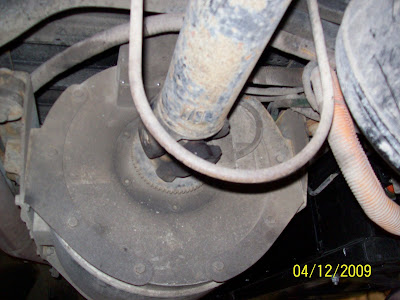 The generator is inline with the driveline and acts as an electric retarder. The generator also provides more horsepower defined in Kilowatts to help the diesel engine with added torque up to 30 mph.
The generator is inline with the driveline and acts as an electric retarder. The generator also provides more horsepower defined in Kilowatts to help the diesel engine with added torque up to 30 mph.
The Computerized Control Unit (CEU) monitors the loads and speeds and sends amperage to the generator from the battery pack to provide braking then allows the generator to recharge the battery pack when the bus is going downhill in the coast mode. Light braking also helps charge the battery pack.
 The generator is water cooled (long life antifreeze) and has a coolant pump to circulate the coolant through the generator body then it returns to the radiator which is specifically for the hybrid system.
The generator is water cooled (long life antifreeze) and has a coolant pump to circulate the coolant through the generator body then it returns to the radiator which is specifically for the hybrid system. The radiator is mounted below the driver's area and has an electric fan that is controlled by the CEU. The coolant pump is also monitored and operated from the computer. The more stop and go driving creates more heat in the generator but creates maximum torque/Horsepower/Kilowatts out of the hybrid system.
The radiator is mounted below the driver's area and has an electric fan that is controlled by the CEU. The coolant pump is also monitored and operated from the computer. The more stop and go driving creates more heat in the generator but creates maximum torque/Horsepower/Kilowatts out of the hybrid system. The battery pack has a main switch that must be turned off when working on the system. The batteries are lithium Ion and weigh far less than previous hybrid systems. They were manufactured in Korea and ENOVA (the developer of this hybrid system) reported very positive testing results with these batteries. The orange covering on the cables indicate high voltage and should be handled with care and properly insulated gloves.
The battery pack has a main switch that must be turned off when working on the system. The batteries are lithium Ion and weigh far less than previous hybrid systems. They were manufactured in Korea and ENOVA (the developer of this hybrid system) reported very positive testing results with these batteries. The orange covering on the cables indicate high voltage and should be handled with care and properly insulated gloves. Previously the battery pack used to be liquid cooled. This caused some minor problems with leaks and maintenance. Now ENOVA has developed an air cooled system that has a standard paper type filter with a high output blower inside the battery case that is funneled throughout the battery pack and exits out the rear of the aluminum encasement (towards the frame).
Previously the battery pack used to be liquid cooled. This caused some minor problems with leaks and maintenance. Now ENOVA has developed an air cooled system that has a standard paper type filter with a high output blower inside the battery case that is funneled throughout the battery pack and exits out the rear of the aluminum encasement (towards the frame).This has been a short over-view of the International School Bus Hybrid Diesel Engine. Please feel free to make any comments & thanks for stopping by...
2 comments :
I just bought a 3116 in a 91 topkick with only 40K. I thought it strange that the BD exhaust brake was disconnected, but it runs fine. It was when I started my service I discovered what I think is why the brake is not working. Also the inner air filter was pulled. Bought new inner/out air and changed fuel filters. Notice a little oil in the exhaust on first start up with new filters. Suspect the exhaust brake blew the turbo, and they pulled the inner and sold her. No smoke and oil consumption is not high,.
BTW you can almost eat off this engine, the truck is CLEAN. THe EXH brake is new.
Rebuild turbo? Adjust valves?
what else before I hook up exhaust brake?
Wayne
It sounds like there is nothing wrong. The exhaust brakes tend to stick with those applications. If they pulled the inner air filter it may be because they didn't want to put a new one in $$$. It's better with both but one is still sufficient. I would hook up the exhaust brake and see how it works. There may be a fault with it and the previous owner didn't want to fix it. They don't make a huge difference in braking since they're not an engine brake.
Post a Comment